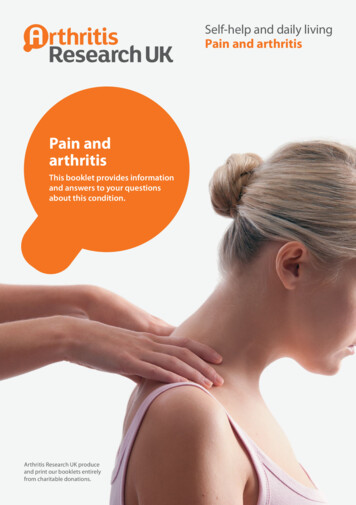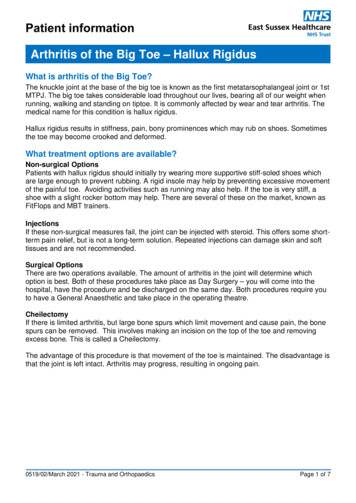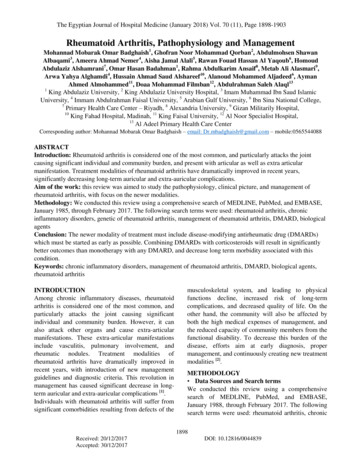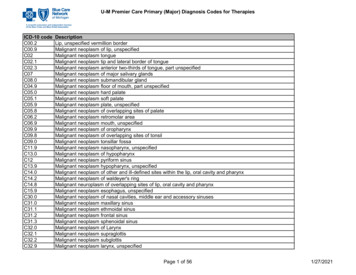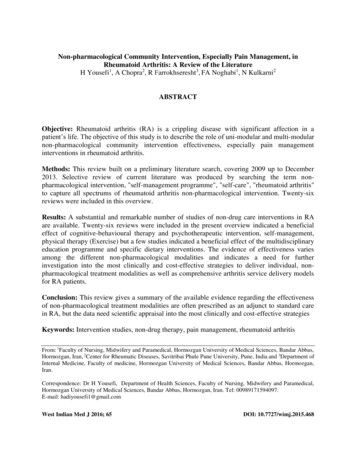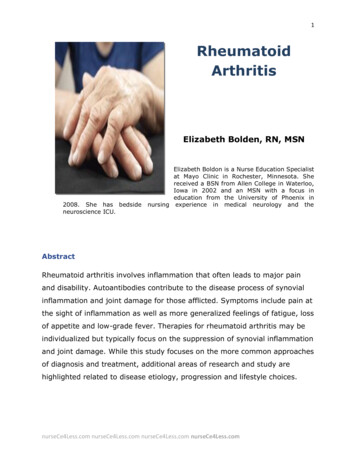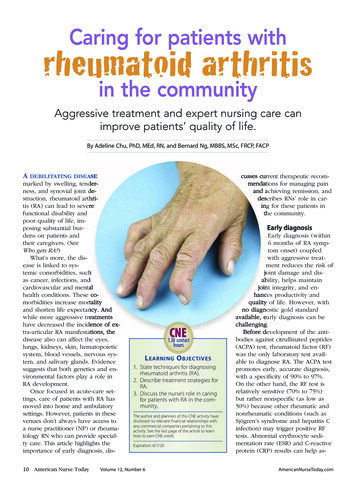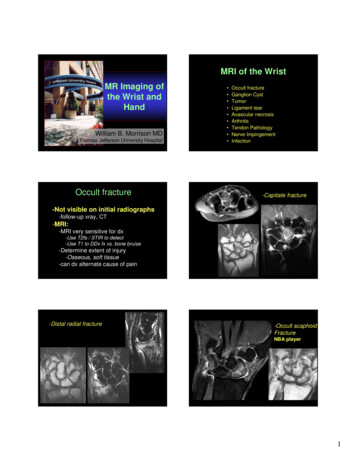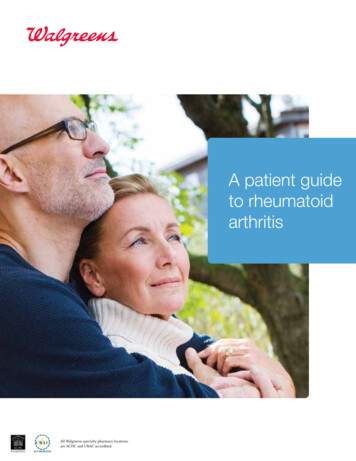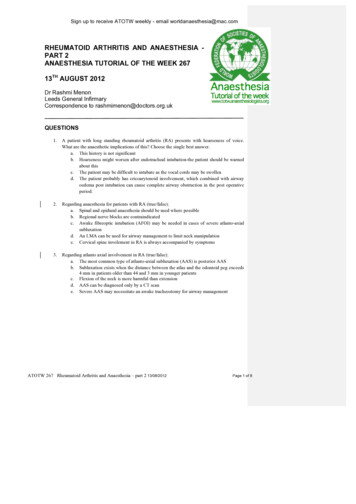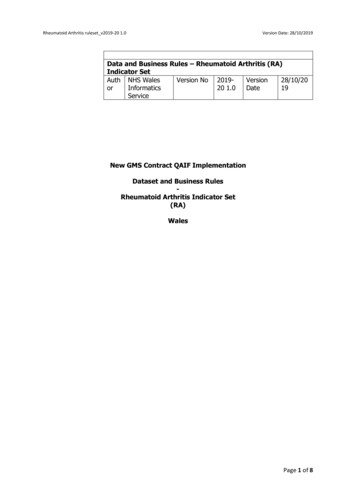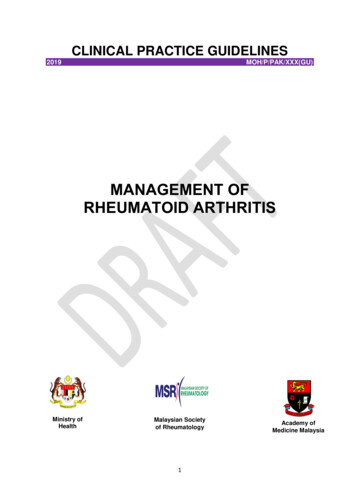
Transcription
CLINICAL PRACTICE GUIDELINES2019MOH/P/PAK/XXX(GU)MANAGEMENT OFRHEUMATOID ARTHRITISMinistry ofHealthMalaysiaMalaysian Societyof Rheumatology1Academy ofMedicine Malaysia
Published by:Malaysia Health Technology Assessment Section (MaHTAS)Medical Development Division, Ministry of Health MalaysiaLevel 4, Block E1, Precinct 1Federal Government Administrative Centre62590 Putrajaya, MalaysiaCopyrightThe copyright owner of this publication is MaHTAS. Content may be reproduced in anynumber of copies and in any format or medium provided that a copyright acknowledgementto MaHTAS is included and the content is not changed, not sold, nor used to promote orendorse any product or service, and not used in an inappropriate or misleading context.ISBN:Available on the following rg.myhttp://www.msr.my/Also available as an app for Android and IOS platform: MyMaHTASSTATEMENT OF INTENTThese clinical practice guidelines (CPG) are meant to be guides for clinical practice, basedon the best available evidence at the time of development. Adherence to these guidelinesmay not necessarily guarantee the best outcome in every case. Every healthcare provideris responsible for the management of his/her unique patient based on the clinical picturepresented by the patient and the management options available locally.UPDATING THE CPGThese guidelines were issued in 2019 and will be reviewed in a minimum period of four years(2023) or sooner if there is a need to do so. When it is due for updating, the Chairman of theCPG or National Advisor of the related specialty will be informed about it. A discussion willbe done on the need for a revision including the scope of the revised CPG. A multidisciplinaryteam will be formed and the latest systematic review methodology used by MaHTAS will beemployed.Every care is taken to ensure that this publication is correct in every detail at the time ofpublication. However, in the event of errors or omissions, corrections will be published in theweb version of this document, which is the definitive version at all times. This version can befound on the websites mentioned above.2
TABLE OF CONTENTSNo.TitlePageKey RecommendationsLevels of Evidence and Formulation of RecommendationGuidelines Development and ObjectivesDevelopment GroupReview CommitteeExternal ReviewersAlgorithm 1 : Diagnosis of Rheumatoid ArthritisAlgorithm 2 : Treatment of Rheumatoid AL FEATURES1-23.INVESTIGATIONS3.1 Laboratory Test3.2 Imaging3.2.1 Plain Radiography3.2.2 Musculoskeletal Ultrasound3.2.3 Magnetic Resonance Imaging22-333-4444.CLASSIFICATION CRITERIA5-65.PROGNOSTIC FACTORS6.REFERRAL7.TREATMENT7.1 Non-Pharmacological7.1.1 Patient Education7.1.2 Occupational Therapy7.1.3 Physiotherapy7.1.4 Podiatry7.1.5 Dietetics7.2 Pharmacological7.2.1 Non-Steroidal Anti-Inflammatory Drugs7.2.2 Corticosteroids7.2.3 Disease Modifying Anti-Rheumatic Drugs (DMARDs)a. Conventional Synthetic DMARDsi. Methotrexateii. Sulfasalazineiii. Hydroxychloroquineiv. Leflunomideb. Targeted Synthetic DMARDsi. Tofacitinibii. Baricitinibc. Biologicsi. Infliximabii. Etanerceptiii. Adalimumabiv. Golimumabv. Tocilizumabvi. Rituximabd. Biosimilarsi. Biosimilar Infliximabii. Biosimilar 4141414151515-161616-1717171818
8.TRADITIONAL AND COMPLEMENTARY MEDICINES189.RHEUMATOLOGY NURSE-LED CARE1810.SPECIAL CONSIDERATIONS10.1 Co-morbidity Management on Treatment10.2 Pregnancy and lactation10.3 Vaccination11.MONITORING AND FOLLOW-UP12.IMPLEMENTING THE GUIDELINES20-2113.REFERENCES22-25Appendix 1Examples of Search StrategyAppendix 2Clinical QuestionsAppendix 3Outcome MeasuresAppendix 4Patient Information LeafletAppendix 5Principles of Joint ProtectionAppendix 6Pharmacological Treatment of Rheumatoid ArthritisAppendix 7Drug MonitoringAppendix 8Tuberculosis Workup Prior To Biologic Therapy In Rheumatoid ArthritisList of AbbreviationsAcknowledgementDisclosure StatementSource of 818-191919-20204
KEY RECOMMENDATIONSThe following recommendations were highlighted by the guidelines Development Group asthe key clinical recommendations that should be prioritised for implementation.Diagnosis and InvestigationRecommendation Consider rheumatoid arthritis if inflammation involving multiple joints is present for atleast six weeks.Recommendation Inflammatory markers and rheumatoid factor anti-citrullinated peptide antibody shouldbe tested when there is clinical suspicion of rheumatoid arthritis.ReferralRecommendation All rheumatoid arthritis (RA) patients should be referred early to the rheumatologists. All RA patients should be primarily managed by rheumatologists.o Co-management plan with primary healthcare providers may be offeredsubsequently.TreatmentRecommendation Aim to achieve a state of clinical remission or at least low disease activity within sixmonths using a treat-to-target strategy in rheumatoid arthritis.Recommendation Patient education should be included in the management of rheumatoid arthritis.Recommendation Short-term (less than three months) low-dose corticosteroids may be used in activerheumatoid arthritis.Recommendation Methotrexate should be used as the first-line Disease Modifying Anti-Rheumatic Drugin all patients with rheumatoid arthritis unless contraindicated.i
LEVELS OF EVIDENCELevelStudy designIEvidence from at least one properly randomised controlled trialII -1Evidence obtained from well-designed controlled trials without randomisationII-2Evidence obtained from well-designed cohort or case-control analytic studies,preferably from more than one centre or groupII-3Evidence from multiple time series with or without intervention. Dramatic results inuncontrolled experiments (such as the results of the introduction of penicillintreatment in the 1940s) could also be regarded as this type of evidenceIIIOpinions of respected authorities based on clinical experience; descriptive studiesand case reports; or reports of expert committeesSOURCE: US/CANADIAN PREVENTIVE SERVICES TASK FORCE 2001FORMULATION OF RECOMMENDATIONIn line with new development in CPG methodology, the CPG Unit of MaHTAS is in theprocess of adapting Grading Recommendations, Assessment, Development andEvaluation (GRADE) in its work process. The quality of each retrieved evidence and itseffect size are carefully assessed/reviewed by the CPG Development Group. In formulatingthe recommendations, overall balances of the following aspects are considered indetermining the strength of the recommendations: overall quality of evidence balance of benefits versus harms values and preferences resource implications equity, feasibility and acceptabilityii
GUIDELINES DEVELOPMENT AND OBJECTIVESGUIDELINES DEVELOPMENTThe members of the Development Group (DG) for these CPG were from the Ministry ofHealth (MoH), Ministry of Education (MoE) and private sector. There was active involvementof a multidisciplinary Review Committee (RC) during the process of the CPG development.A systematic literature search was carried out using the following electronicdatabases/platforms: mainly Medline via Ovid and Cochrane Database of Systemic Reviewsand others e.g. Pubmed and Guidelines International Network (G-I-N). Refer to Appendix 1for Example of Search Strategy. The inclusion criteria are all patients with rheumatoidarthritis regardless of study design. The search was limited to literature published in the last15 years and on humans and in English. In addition, the reference lists of all retrievedliterature and guidelines were searched and experts in the field contacted to identify relevantstudies. All searches were conducted from 29 May 2017 to 2 June 2017. Literature searchwas repeated for all clinical questions at the end of the CPG development process allowingany relevant papers published before 31 January 2019 to be included. Future CPG updateswill consider evidence published after this cut-off date. The details of the search strategy canbe obtained upon request from the CPG Secretariat.Reference was also made to other guidelines as listed below: Rheumatoid Arthritis in Adults: Management [National Institute for Health and ClinicalExcellence (NICE), July 2018] Management of Early Rheumatoid Arthritis [Scottish Intercollegiate Guidelines Network(SIGN), February 2011]The CPGs were evaluated using the Appraisal of Guidelines for Research and Evaluation(AGREE) II prior to being used as reference.A total of seven main clinical questions were developed under different sections. Membersof the DG were assigned individual questions within these sections. Refer to Appendix 2 forClinical Questions. The DG members met 19 times throughout the development of theseguidelines. All literatures retrieved were appraised by at least two DG members using CriticalAppraisal Skill Programme checklist, presented in evidence tables and further discussed ineach DG meetings. All statements and recommendations formulated after that were agreedupon by both the DG and RC. Where evidence was insufficient, the recommendations weremade by consensus of the DG and RC. Any differences in opinion are resolved consensually.The CPG was based largely on the findings of systematic reviews, meta-analyses and clinicaltrials, with local practices taken into consideration.The literatures used in these guidelines were graded using the US/Canadian PreventiveServices Task Force Level of Evidence (2001) while the grading of recommendation wasdone using the principles of GRADE (refer to the preceding page). The writing of the CPGfollows strictly the requirement of AGREE II.On completion, the draft CPG was reviewed by external reviewers. It was also posted on theMoH Malaysia official website for feedback from any interested parties. The draft was finallypresented to the Technical Advisory Committee for CPG, and the Health TechnologyAssessment (HTA) and CPG Council, MoH Malaysia, for review and approval. Details on theCPG development by MaHTAS can be obtained from Manual on Development andImplementation of Evidence-based Clinical Practice Guidelines published in 2015 (availableat http://www.moh.gov.my/penerbitan/mymahtas/CPG MANUAL MAHTAS.pdf)iii
OBJECTIVESThe objectives of the CPG are to provide evidence-based recommendations on rheumatoidarthritis (RA) on the following aspects: diagnosis investigations treatment (non-pharmacological and pharmacological) special considerations referral and follow-upCLINICAL QUESTIONSRefer to Appendix 2.TARGET POPULATIONInclusion Criteria All patients with RA (16 years and above)Exclusion criteria Juvenile-onset Idiopathic ArthritisTARGET GROUP/USERThis CPG is intended to guide those involved in the management of RA either in primary orsecondary/tertiary care (public and private practice) namely: doctors allied health professionals trainees and medical students policy makers patients and their advocates professional societiesHEALTHCARE SETTINGSPrimary and secondary/tertiary care settingsiv
DEVELOPMENT GROUPChairpersonDatin Dr. Asmahan Mohamed IsmailConsultant RheumatologistHospital Raja Perempuan Zainab II, KelantanMembers (alphabetical order)Dr. Asmah MohdConsultant RheumatologistHospital Sultanah Nur Zahirah, TerengganuDr. Mohd. Aminuddin Mohd. YusofHead of CPG Unit & Public Health PhysicianHealth Technology Assessment SectionMinistry of Health Malaysia, PutrajayaDr. Chong Chin EuPrincipal Assistant DirectorHealth Technology Assessment SectionMinistry of Health Malaysia, PutrajayaMs. Noornazli Zahirah AbdullahPharmacistHospital Putrajaya, PutrajayaDr. Chong Hwee ChengConsultant RheumatologistHospital Melaka, MelakaDr. Norhaslira Abdul RahimFamily Medicine SpecialistKlinik Kesihatan Sg. Besi, Kuala LumpurMs. Chu Ai ReenOccupational TherapistHospital Tuanku Ja’afar, Negeri SembilanDr. Shereen Ch’ng SuyinConsultant RheumatologistHospital Selayang, SelangorDr. Habibah Mohamed YusoofConsultant RheumatologistHospital Selayang, SelangorDr. Tan Bee EngConsultant RheumatologistGleneagles Penang, Pulau PinangDr. Hazlyna BaharuddinLecturer & Consultant RheumatologistFaculty of MedicineUniversiti Teknologi MARA, SelangorDr. Zil Azwan AbdullahFamily Medicine SpecialistKlinik Kesihatan Presint 9, PutrajayaDr. Liza Mohd IsaConsultant RheumatologistHospital Putrajaya, Putrajayav
REVIEW COMMITTEEThe draft CPG was reviewed by a panel of experts from both public and private sectors. Theywere asked to comment primarily on the comprehensiveness and accuracy of theinterpretation of evidence supporting the recommendations in the CPG.ChairpersonDr. Mollyza Mohd. ZainSenior Consultant Rheumatologist(National Head of Clinical Service Rheumatology)Hospital Selayang, SelangorMembers (alphabetical order)Dato’ Dr. Azmillah Hj. RosmanSenior Consultant RheumatologistHospital Selayang, SelangorDr. Hjh. Rosaida Hj. Md. SaidConsultant Gastroenterologist & HepatologistHospital Ampang, SelangorDr. Chow Sook KhuanConsultant RheumatologistSunway Medical Centre, SelangorAssoc. Prof. Dr. Sargunan SockalingamLecturer & Consultant RheumatologistUniversiti Malaya, Kuala LumpurMs. Ding Mee HongPatient AdvocateDr. Siti Aminah Akbar MericanConsultant Family MedicineKlinik Kesihatan Batu Rakit, TerengganuDato’ Dr. Gun Suk ChynSenior Consultant RheumatologistHospital Tuanku Ja’afar, Negeri SembilanMs. Siti Rabi’atul ‘Adawiyah NasriPharmacistHospital Tuanku Ja’afar, Negeri SembilanDr. Junainah SabirinDeputy DirectorHealth Technology Assessment SectionMinistry of Health Malaysia, PutrajayaDr. Yoong Kar YawHead of Department & State PhysicianHospital Sultan Ismail, Johorvi
EXTERNAL REVIEWERS (alphabetical order)Mr. Ang Yu JoePharmacistHospital Selayang, SelangorDr. Rozita ZakariaConsultant Family Medicine SpecialistKlinik Kesihatan Presint 18, PutrajayaDr. Foo Meng HowGeneral PractitionerKlinik Foo Sdn. Bhd., KelantanDatuk Dr. Sheikh Mohd. Amin Sheikh MubarakDean of Graduate Studies & Family MedicineSpecialistAcademy of Family Physicians of Malaysia(AFPM)Adj. Prof. Dr. Geoffrey O. LittlejohnConsultant RheumatologistMonash University, AustraliaMs. Tan Foo LanOccupational TherapistHospital Tengku Ampuan Rahimah, SelangorAdj. Prof. Dr. Koh Ee TzunConsultant RheumatologistTan Tock Seng Hospital, SingaporeDatuk Dr. Tarmizi Thayaparan AbdullahPart Time LecturerInternational Medical University, Negeri SembilanProf. Dr. Mohd Shahrir Mohamed SaidConsultant RheumatologistUniversiti Kebangsaan MalaysiaDr. Yeap Swan SimConsultant RheumatologistSubang Jaya Medical Centre, SelangorProf. Dr. Rohini HandaSenior Consultant RheumatologistIndraprastha Apollo Hospitals, IndiaDr. Yoon Chee KinConsultant PhysicianHospital Pulau Pinang, Pulau Pinangvii
ALGORITHM 1. DIAGNOSIS OF RHEUMATOID ARTHRITISInflammatory joint symptoms and/orpositive serology (RF onof talultrasoundYesSynovitisdetected?No Reassurance Consider o Inflammatoryarthritis forclosemonitoringModified:1. D'Agostino MA, Terslev L, Wakefield R, et al. Novel algorithms for the pragmatic use of ultrasoundin the management of patients with rheumatoid arthritis: from diagnosis to remission. Ann RheumDis. 2016 Nov;75(11):1902-1908.2. van Steenbergen HW, Aletaha D, Beaart-van de Voorde LJ, et al. EULAR definition of arthralgiasuspicious for progression to rheumatoid arthritis. Ann Rheum Dis. 2017;76(3):491-496.*presence of a first-degree relative with RAraised inflammatory markerspresence of extra-articular featuresACPA: anti-citrullinated peptide antibodyACR/EULAR: American College of Rheumatology/European League Against RheumatismRA: rheumatoid arthritisRF: rheumatoid factorviii
ALGORITHM 2. TREATMENT OF RHEUMATOID ARTHRITISFulfilled classification criteria of mentFirst LineConventional syntheticDMARDsPatient Education Disease information Medications Lifestyle modificationSecond LineAllied Health Care Physiotherapy Occupational therapyBiologic DMARDsorTargeted syntheticDMARDsNurse-led CareDMARDs: Disease Modifying Anti-Rheumatic DrugsNSAIDs: Non-Steroidal Anti-Inflammatory Drugs (selective and non-selective)RA: Rheumatoid ArthritisixAdd-on therapy NSAIDs Corticosteroids
1.INTRODUCTIONRheumatoid arthritis (RA) is a chronic, progressive autoimmune disease of unknownaetiology causing inflammation of the joints. It is characterised by uncontrolled proliferationof synovial tissue and a wide array of multisystem co-morbidities. The disease has aninsidious onset with unpredictable and variable courses. Typically, RA manifests assymmetrical polyarthritis but may also present with non-specific symptoms e.g. fatigue,malaise and mild fever. Bone erosion, destruction of cartilage and complete loss of jointintegrity can occur over time if treatment is delayed or inadequate.Numerous multicentre international studies have shown that disease progression can beminimised with early and appropriate treatment. Treatment paradigm of RA has evolved overthe last two decades with the advent of biologics and implementation of treat-to-target (T2T)strategy.The Malaysian National Inflammatory Arthritis Registry (NIAR) shows that nearly 50% ofcases are diagnosed a year after the onset of symptoms. This delay in diagnosis may be dueto lack of awareness and understanding of the disease among public and healthcareproviders. Furthermore, limited human, financial and infrastructure resources may alsocontribute to the difficulty of accessing rheumatology care.This is the first national CPG on the management of RA aimed to increase awareness amonghealth care providers for recognition of early RA, timely referral to rheumatologist andinitiation of treatment. We hope that this CPG will foster close collaboration between variousstakeholders in providing evidence-based management of RA to improve outcomes andultimately patients’ quality of life (QoL).2.CLINICAL FEATURESClinical features of RA can be divided into articular and extra-articular manifestations. Extraarticular features may involve multiple organs including the skin, eyes, lungs and bloodvessels. Non-specific systemic features such as fever, malaise and weight loss may precedeovert joint symptoms.RA may be associated with other connective tissue diseases and chronic non inflammatorypain e.g. fibromyalgia. It is also an independent risk factor for cardiovascular (CV) diseasesand osteoporosis.The key presenting symptoms of joint inflammation are: joint pain and swelling early morning stiffness lasting 60 minutesThe typical articular pattern of RA is symmetrical polyarthritis affecting: metacarpophalangeal (MCP) joints proximal interphalangeal (PIP) joints interphalangeal joint of thumbs wrists elbows metatarsophalangeal (MTP) jointsThe symptoms of joint inflammation should be present for at least six weeks.Findings on physical examination include: clinical synovitiso joint tenderness1
o boggy swelling (may be subtle in early RA) restricted range of motion joint deformities e.g. radial deviation of the wrist, ulnar deviation at the MCPs, “swanneck” [flexion of distal interphalangeal (DIP) joint, hyperextension of PIP] and“boutonniere” (hyperextension of DIP, flexion of PIP) deformities.Differential diagnosis of polyarthritis should take into consideration: duration of symptoms pattern of joint involvement presence of systemic features and/or other diseasesImportant differentials include: psoriatic arthritis erosive inflammatory osteoarthritis polyarticular gout arthritis related to infection systemic lupus erythematosus Early diagnosis and prompt treatment of RA are mandatory to prevent irreversible jointdamage.Recommendation 1 Consider rheumatoid arthritis if inflammation involving multiple joints is present for atleast six weeks.3.INVESTIGATIONSLaboratory and imaging investigations are done to assist in diagnosis, screening of preexisting abnormalities and co-morbidities prior to initiation of Disease Modifying AntiRheumatic Drugs (DMARDs) as well as monitoring of treatment-related AEs (adverseevents).3.1Laboratory testRelevant laboratory tests in RA are shown in table below.Table 1. Laboratory Investigations in RAPhase of managementInvestigationsDiagnosis inflammatory markerso erythrocyte sedimentation rate (ESR) and/oro C-reactive protein (CRP) rheumatoid factor (RF) and/or anti-citrullinated peptide antibody (ACPA)*Pre-treatment and comorbidities screening full blood count (FBC)renal profile (RP)fasting blood sugarfasting lipid profile2
liver function test (LFT) viral hepatitis screening [hepatitis B surface antigen(HBsAg)], hepatitis C screening human immunodeficiency virus (HIV) if risk factor presentTreatmentDisease activitymonitoring andtreatment AEs FBCRPLFTESR and CRPPre-biologic therapy anti-hepatitis B core if HBsAg negativeMantoux Interferon Gamma Release Assay (IGRA)HIV screeningImmunoglobulin (Ig) G, A and M [prior to rituximab (RTX)]*ACPA is the current accepted terminology for anti-cyclic citrullinated peptide and can be usedinterchangeably.RF and ACPA have similar diagnostic sensitivity (67% and 79% respectively)1 but ACPA hashigher specificity compared with RF (95 - 98% and 79 - 85% respectively).1-2 Presence ofboth RF and ACPA indicate more severe disease. ACPA should be considered in clinicallysuspected RA where RF is negative. Both RF and ACPA are not recommended for diseasemonitoring. Positive RF does not equate to RA as it is present in normal population with a higherincidence in the elderly. Negative RF does not exclude RA as 30 - 40% of RA are seronegative for RF.3-4Recommendation 2 Inflammatory markers and rheumatoid factor anti-citrullinated peptide antibody shouldbe tested when there is clinical suspicion of rheumatoid arthritis.3.2Imaging3.2.1 Plain Radiographa. Chest X-RayChest X-ray is performed at baseline evaluation and repeated on follow-up for assessmentof disease complications and co-morbidities. It is also mandatory to be done as part of prebiologic tuberculosis screening (refer to Appendix 8).b. Hand X-RayPlain radiograph is the most common modality used to assess the joints. It may be normalwithin the first six months of RA onset. The radiograph findings include soft-tissue swelling,juxta-articular demineralisation, joint space narrowing and bone erosions. These changesare symmetrical and spare the distal IP joints. Refer to Figure 1 and 2.3
ABFigure 1. Anteroposterior view (AP) of hands in early RA:(A) periarticular osteopenia and (B) soft tissue swellingCEABDFigure 2. AP and supinator oblique views of hands in advanced RA: (A) Ulnardeviation of fingers at MCP joints (B) hitchhiker thumb deformity (C) Boutonnieredeformity. Subchondral cyst (D), sclerosis (E) and joint space narrowing atradiocarpal, PIP, MCP joints and carpal bones.3.2.2 Musculoskeletal ultrasoundMusculoskeletal ultrasound is a useful bedside tool that is increasingly being used byrheumatologists to aid early diagnosis and management of RA. Ultrasound is more accuratethan clinical assessment in early RA patients especially those with negative ACPA: Clinical synovitis (tender or swollen joint) vs subclinical synovitis (ultrasounddetected):5, level II-2o Gray Scale (GS) 1: sensitivity 58.8% vs 78.0%, specificity 79.4% vs 79.4%o GS 1/Power Doppler (PD) 1: sensitivity 58.5% vs 56.2%, specificity 79.4% vs 93.7% In patients with negative ACPA, combining ultrasound detected synovitis joint countswith 2010 ACR/EULAR classification criteria increased diagnostic sensitivity from 55.2%to 72.4% and specificity from 78.5% to 87.7%.6, level II-2Presence of ultrasound detected synovitis increases the prevalence of clinical synovitis. Thismay classify patients with musculoskeletal symptoms who subsequently require MTX moreaccurately.5-7, level II-24
Ultrasound of the joints is useful in detecting subclinical synovitis for suspectedinflammatory arthritis including RA.3.2.3 Magnetic Resonance ImagingMagnetic resonance imaging (MRI) is another imaging modality in detecting synovitis inhands and wrists in early RA which may not be clinically evident: In a systematic review, MRI hand and wrist had good accuracy in the diagnosis of RAin patients with 6 months disease duration (AUC 0.81).8, level l MRI synovitis in PIP joint is a strong predictor of early RA without typical symptoms(OR 3.1, 95% CI 1.2 to 8.1).9, level II-2MRI can detect synovitis, bone erosions and bone marrow oedema better than conventionalradiography but its use is limited due to cost and availability.4.CLASSIFICATION CRITERIARA should be suspected in patients who present with inflammatory polyarthritis. Initialevaluation of such patients requires a careful history, physical examination and selectedlaboratory tests to identify features that are characteristics of RA. Patients are classified asRA based on the criteria established by American College of Rheumatology/EuropeanLeague Against Rheumatism (ACR/EULAR) 2010 (refer to Table 2). This classificationcriteria supersedes the older ACR 1987 revised criteria.Table 2. The 2010 American College of Rheumatology/European League AgainstRheumatism Classification Criteria for Rheumatoid ArthritisScoresTarget population (Who should be tested?): Patients who1) have at least 1 joint with definite clinical synovitis (swelling)2) with the synovitis not better explained by another diseaseClassification criteria for RA (score-based algorithm: add score of categories A- D; a score of 6/10 is needed for classification of a patient as having definiteRA)A. Joint involvement1 large joint2 - 10 large joints1 - 3 small joints (with or without involvement of large joints)4 - 10 small joints (with or without involvement of large joints) 10 joints (at least 1 small joint)01235B. Serology (at least 1 test result is needed for classification)Negative RF and negative ACPALow-positive RF or low-positive ACPAHigh-positive RA or high-positive ACPA023C. Acute-phase reactants (at least 1 test result is needed forclassification)Normal CRP and normal ESRAbnormal CRP or abnormal ESR01D. Duration of symptoms 6 weeks05
6 weeks1Source: Aletaha D, Neogi T, Silman AJ, et al. 2010 Rheumatoid arthritis classification criteria: anAmerican College of Rheumatology/European League Against Rheumatism collaborativeinitiative. Arthritis Rheum. 2010 Sep;62(9):2569-81.A score of 6 is classified as having definite RAA score of 6 might fulfil the criteria over timeThere are four domains in the classification criteria:A. Joint involvement (swollen or tender joint on examination, which may be confirmed byimaging evidence of synovitis)Large joints refer to shoulders, elbows, hips, knees and ankles.Small joints refer to MCPs, PIPs, second through fifth MTPs, thumb IPs and wrists.*DIP joints, first carpometacarpal joints and first MTP joints are excluded fromassessment.B. SerologyHigh positive refers to International Unit values 3 times upper limit normal.C. Acute-phase reactantsNormal or abnormal is determined by local laboratory standards.D. DurationPatient self-report of the duration of signs or symptoms of synovitis5.PROGNOSTIC FACTORSMany factors can influence the outcomes of RA and awareness of these will guide healthcareproviders on early referral for initiation of treatment.Poor prognostic factors in RA are: older age (OR 1.45, 95% CI 1.08 to 1.94)10, level II-2 female (OR 3.36, 95% CI 1.20 to 9.40)11, level II-2 obesity (OR 5.2, 95% CI 1.8 to 15.2)12, level I smoking (OR 2.17, 95% CI 1.06 to 4.45)13, level I presence of ACPA/anti-cyclic citrullinated peptide (anti-CCP) (OR ranging from 1.01 to4.22)11, level II-2; 14, level I; 15-16, level II-2; 17, level III presence of RF (OR ranging from 2.483 to 3.64)10-11, level II-2; 18, level III high CRP (OR ranging from 1.04 to 1.52)13, level I; 19, level II-2 high ESR (OR ranging from 1.72 to 3.20)11, level II-2; 13, level I; 15, level II-2 anaemia20, level II-2 high erosion score at baseline (OR ranging from 2.29 to 18.060)13, level I; 16, level II-2; 19, levelII-26.REFERRALAll RA patients should be primarily managed by rheumatologists. This is due to thecomplexity of making a definite diagnosis and ensuring adequate treatment of the disease.Indications for referral are as listed below:21-22a. Referral for diagnosis1. Clinical suspicion of RA, which is supported by the presence of any of the following: more than three swollen joints MCP/MTP joint involvement with positive squeeze test (refer to Figure 3) early morning stiffness of more than 30 minutes6
Figure 3. Positive Squeeze Test2. Clinical evidence of persistent synovitis of undetermined causeb. Referral following diagnosis1. Development of a co-management plan2. Optimisation of therapy in active disease3. Disease or treatment related complications e.g. acute flare or severe infectionc. Referral of patients with special considerations3. Pre-pregnancy care, pregnancy and lactation4. History of hepatitis B and/or hepatitis C5. History of malignancy Referral of RA cases to rheumatology clinic should provide the following information:o Symptoms and signs: duration, joint distribution, severity, impact on activity of dailyliving and extra-articular involvemento Co-morbidities that might require further medical assessmento Current medicationso Relevant investigation resultsRecommendation 3 All rheumatoid arthritis (RA) patients should be referred early to the rheumatologists. All RA patients should be primarily managed by rheumatologists.o Co-management plan with primary healthcare providers may be offeredsubsequently.7.TREATMENTOptimal care of patients with RA consists of an integrated approach that includes both nonpharmacological and pharmacological treatments (refer to Algorithm 2). Pharmacologicaltreatment should be in
Inflammatory markers and rheumatoid factor anti-citrullinated peptide antibody should be tested when there is clinical suspicion of rheumatoid arthritis. Recommendation All rheumatoid arthritis (RA) patients should be referred early to the rheumatologists. All RA patients should be primarily managed by rheumatologists.
